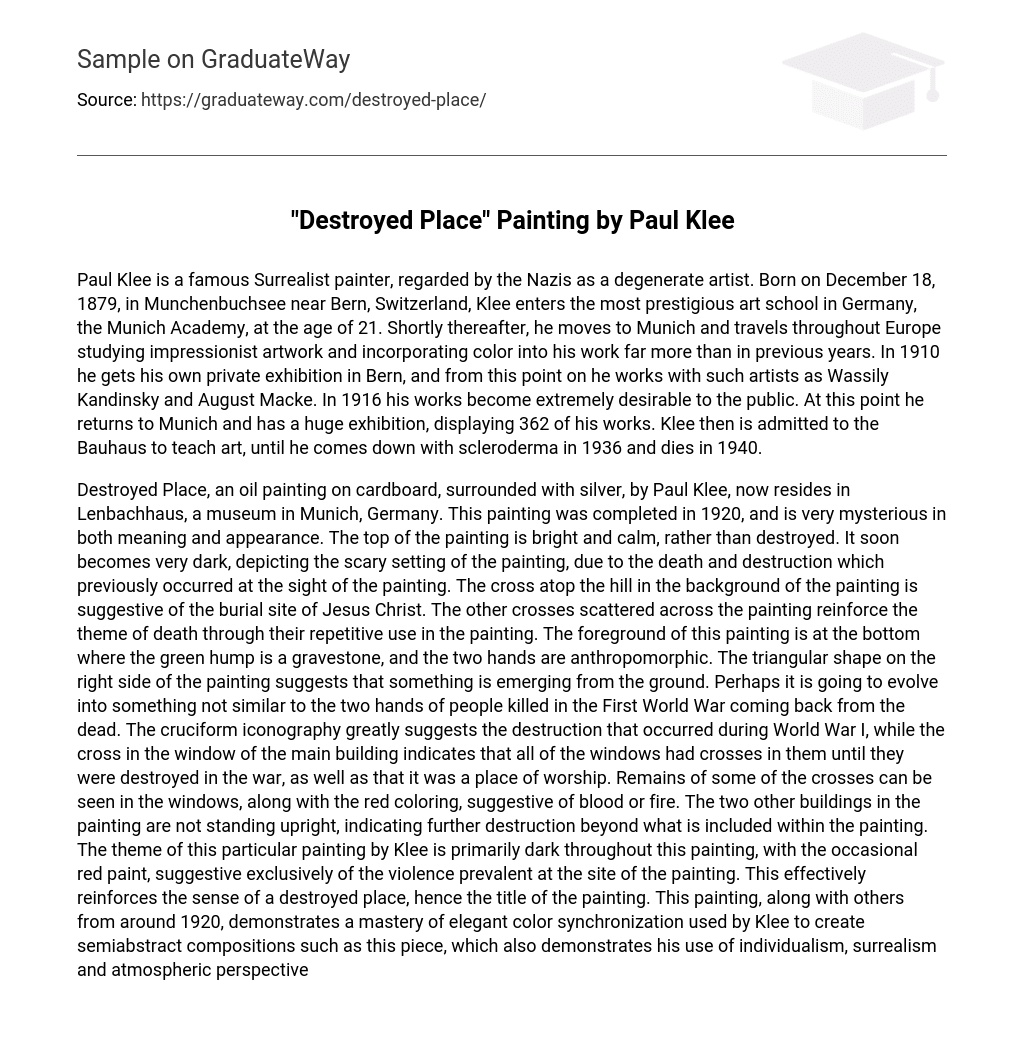Paul Klee, a renowned Surrealist painter, was considered a degenerate artist by the Nazis. He was born on December 18, 1879, in Munchenbuchsee near Bern, Switzerland. At the age of 21, Klee gets accepted into the prestigious Munich Academy, the most esteemed art school in Germany. He subsequently moves to Munich and explores various European countries, studying impressionist artwork and incorporating vibrant colors into his works more extensively than before. In 1910, Klee holds his personal exhibition in Bern, collaborating with artists such as Wassily Kandinsky and August Macke thereafter. By 1916, his artworks become highly coveted by the public, prompting a massive exhibition in Munich showcasing a collection of 362 of his pieces. Klee later joins the Bauhaus as an art instructor until he is diagnosed with scleroderma in 1936. Tragically, he passes away in 1940.
Paul Klee’s oil painting on cardboard, Destroyed Place, is now housed in Munich, Germany’s Lenbachhaus museum. Completed in 1920, this enigmatic piece is characterized by its mysterious meaning and appearance. The painting’s upper portion emits a bright and serene atmosphere, in contrast to the destruction portrayed beneath. The dark, ominous setting alludes to the previous death and devastation that occurred at this location. The hill in the background features a prominently displayed cross, symbolizing the burial site of Jesus Christ. Numerous crosses scattered throughout the painting further reinforce the theme of death through their repetitive use. Positioned at the painting’s bottom, the foreground showcases a green hump resembling a gravestone, as well as two anthropomorphic hands. A triangular shape on the right side suggests an emerging figure, potentially unrelated to the reanimated hands of those who perished in World War I. The prevalent use of cruciform iconography signifies the destruction wrought by the war, while a cross seen in one of the building’s windows signifies its past function as a place of worship. Remnants of demolished crosses can still be observed in some windows, juxtaposed with red coloring that evokes imagery of blood or fire.The two additional buildings depicted in the artwork are not depicted in an upright position, indicating that there is even more destruction outside the frame of the painting. The predominant theme of this particular painting by Klee is darkness, with occasional red paint symbolizing violence at the depicted location. This effectively reinforces the sense of devastation, hence the painting’s title. Like his other works from around 1920, this painting showcases Klee’s mastery of harmonious color combinations, creating semiabstract compositions that also incorporate individualism, surrealism, and atmospheric perspective. Similar to his Bauhaus colleague Kandinsky, Klee moves away from depicting nature in his artwork while still embracing surrealism. Surrealism involves complex symbolism, exemplified by the hand and gravestone in “Destroyed Place,” prompting viewers to analyze these abstract symbols to understand the intended meaning of the painting. In contrast to many of Klee’s other works, this piece does not incorporate cubism throughout the entire composition. Instead, Klee endeavors to depict an actual scene of destruction in this painting. Unlike his more abstract pieces, this artwork holds a clear and defined significance.
This piece combines elements found in old paintings from the Renaissance period of art, such as individualism and atmospheric perspective. The artist, Klee, who lived in Germany, used this piece to express his disapproval of the deaths happening during the Great War and to raise awareness about the destruction caused by the war. The painting effectively employs atmospheric perspective by depicting a large gravestone and brighter colors, suggesting that the destruction is not personally affecting the viewers. However, the path leading to the house serves as a reminder that the destruction is nearby and anyone can easily encounter death and destruction.
Bibliography: Harden, Mark. Destroyed Place, May 2000.
Christian, Kevin. “Paul Klee Chronological Biography and Timeline”, available at http://ourworld.compuserve.com/homepages/kevin_christian/kleebio.htm, from May 2000.
Jones, Howard. Interview with Justin Pevnick at John Burroughs School in Saint Louis on 18 May 2000.





